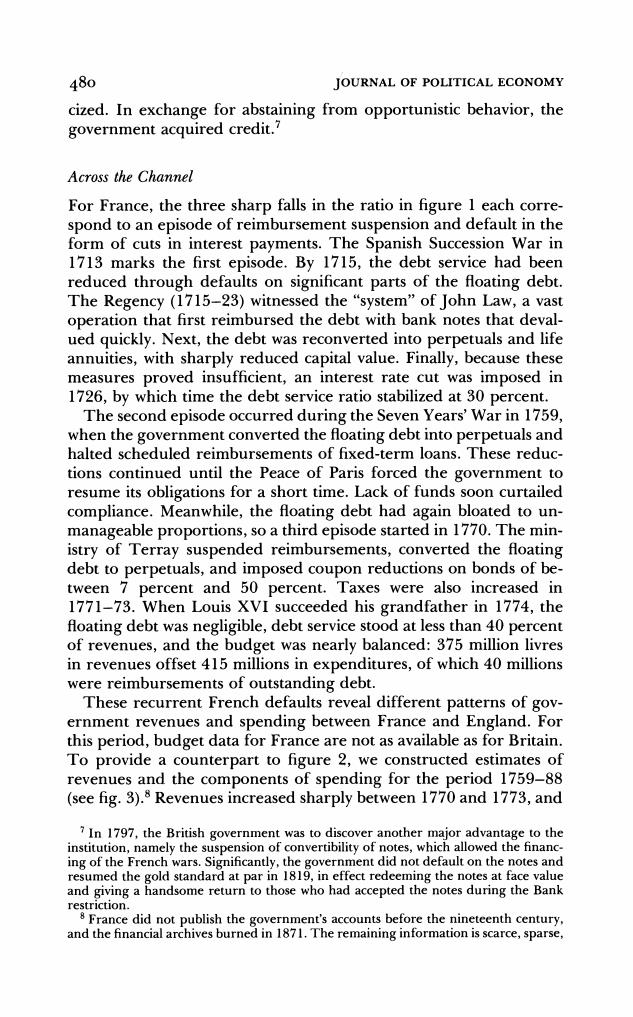正在加载图片...

480 JOURNAL OF POLITICAL ECONOMY cized.In exchange for abstaining from opportunistic behavior,the government acquired credit.? Across the Channel For France,the three sharp falls in the ratio in figure 1 each corre- spond to an episode of reimbursement suspension and default in the form of cuts in interest payments.The Spanish Succession War in 1713 marks the first episode.By 1715,the debt service had been reduced through defaults on significant parts of the floating debt. The Regency (1715-23)witnessed the "system"of John Law,a vast operation that first reimbursed the debt with bank notes that deval- ued quickly.Next,the debt was reconverted into perpetuals and life annuities,with sharply reduced capital value.Finally,because these measures proved insufficient,an interest rate cut was imposed in 1726,by which time the debt service ratio stabilized at 30 percent. The second episode occurred during the Seven Years'War in 1759, when the government converted the floating debt into perpetuals and halted scheduled reimbursements of fixed-term loans.These reduc- tions continued until the Peace of Paris forced the government to resume its obligations for a short time.Lack of funds soon curtailed compliance.Meanwhile,the floating debt had again bloated to un- manageable proportions,so a third episode started in 1770.The min- istry of Terray suspended reimbursements,converted the floating debt to perpetuals,and imposed coupon reductions on bonds of be- tween 7 percent and 50 percent.Taxes were also increased in 1771-73.When Louis XVI succeeded his grandfather in 1774,the floating debt was negligible,debt service stood at less than 40 percent of revenues,and the budget was nearly balanced:375 million livres in revenues offset 415 millions in expenditures,of which 40 millions were reimbursements of outstanding debt. These recurrent French defaults reveal different patterns of gov- ernment revenues and spending between France and England.For this period,budget data for France are not as available as for Britain. To provide a counterpart to figure 2,we constructed estimates of revenues and the components of spending for the period 1759-88 (see fig.3).8 Revenues increased sharply between 1770 and 1773,and 7 In 1797,the British government was to discover another major advantage to the institution,namely the suspension of convertibility of notes,which allowed the financ- ing of the French wars.Significantly,the government did not default on the notes and resumed the gold standard at par in 1819,in effect redeeming the notes at face value and giving a handsome return to those who had accepted the notes during the Bank restriction. 8 France did not publish the government's accounts before the nineteenth century, and the financial archives burned in 1871.The remaining information is scarce,sparse,480 JOURNAL OF POLITICAL ECONOMY cized. In exchange for abstaining from opportunistic behavior, the government acquired credit.7 Across the Channel For France, the three sharp falls in the ratio in figure 1 each correspond to an episode of reimbursement suspension and default in the form of cuts in interest payments. The Spanish Succession War in 1713 marks the first episode. By 1715, the debt service had been reduced through defaults on significant parts of the floating debt. The Regency (1715-23) witnessed the "system" of John Law, a vast operation that first reimbursed the debt with bank notes that devalued quickly. Next, the debt was reconverted into perpetuals and life annuities, with sharply reduced capital value. Finally, because these measures proved insufficient, an interest rate cut was imposed in 1726, by which time the debt service ratio stabilized at 30 percent. The second episode occurred during the Seven Years' War in 1759, when the government converted the floating debt into perpetuals and halted scheduled reimbursements of fixed-term loans. These reductions continued until the Peace of Paris forced the government to resume its obligations for a short time. Lack of funds soon curtailed compliance. Meanwhile, the floating debt had again bloated to unmanageable proportions, so a third episode started in 1770. The ministry of Terray suspended reimbursements, converted the floating debt to perpetuals, and imposed coupon reductions on bonds of between 7 percent and 50 percent. Taxes were also increased in 1771-73. When Louis XVI succeeded his grandfather in 1774, the floating debt was negligible, debt service stood at less than 40 percent of revenues, and the budget was nearly balanced: 375 million livres in revenues offset 415 millions in expenditures, of which 40 millions were reimbursements of outstanding debt. These recurrent French defaults reveal different patterns of government revenues and spending between France and England. For this period, budget data for France are not as available as for Britain. To provide a counterpart to figure 2, we constructed estimates of revenues and the components of spending for the period 1759-88 (see fig. 3).8 Revenues increased sharply between 1770 and 1773, and 7 In 1797, the British government was to discover another major advantage to the institution, namely the suspension of convertibility of notes, which allowed the financing of the French wars. Significantly, the government did not default on the notes and resumed the gold standard at par in 1819, in effect redeeming the notes at face value and giving a handsome return to those who had accepted the notes during the Bank restriction. 8 France did not publish the government's accounts before the nineteenth century, and the financial archives burned in 1871. The remaining information is scarce, sparse